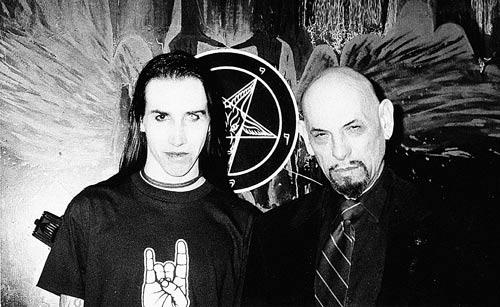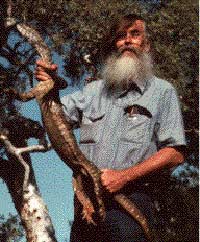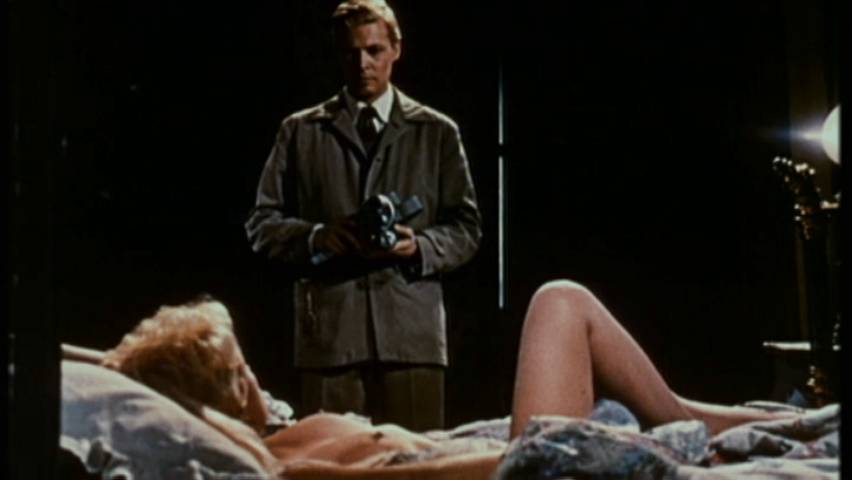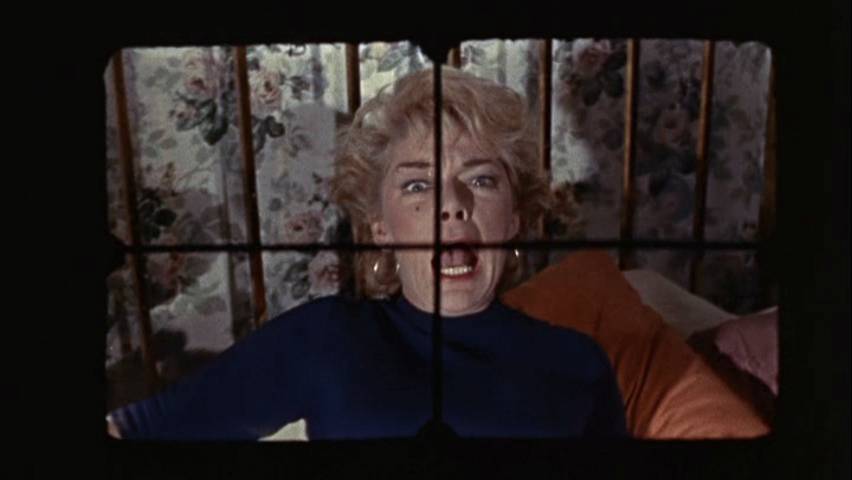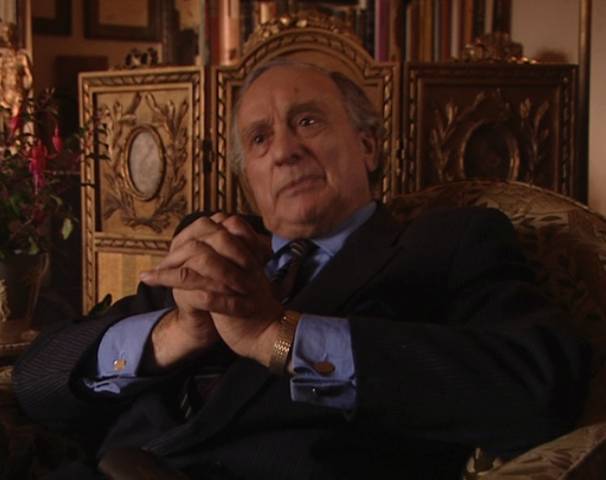Assorted Weirdness
First off, it turns out that the photo of John Kerry and Anton LaVey appears to be a hoax – which serves me right, I suppose, for rather gratuitously tacking it onto the last newsletter. Snopes.com has debunked the photo, and, while Snopes.com is far from being the most credible source of information, their debunking of this particular hoax appears pretty convincing. (http://www.snopes.com/photos/politics/lavey.asp)
The hoax photo was created by persons unknown by combining the photo to the left of LaVey alongside one of his disciples, Marilyn Manson, and the photo to the right of Kerry with some guy named Rami Salami. I have to say though that it is a pretty clever hoax that someone obviously spent a little time on. Reversing the images and adding shadowing behind Kerry are clever touches, as are the fake edition of the San Francisco Chronicle, the clever caption added to the photo, and the inclusion of a portion of a fabricated article. Kudos to whoever created this hoax – but please don’t do it again. It makes me look bad.
There is also some controversy over the comments attributed to ecologist Eric Pianka, with Pianka claiming that his lecture was misrepresented by an academic rival seeking to tarnish his reputation (
http://www.cbc.ca/story/science/national/2006/04/05/ecology-prof-20060405.html?print). Pianka, however, didn’t actually deny the genocidal comments attributed to him, and a university spokesman, curiously enough, defended Pianka’s right to hold such views: “‘We have a lot of different points of view on the University of Texas at Austin campus. And we certainly support our faculty in saying what they think,’ said Don Hale, a spokesman for the University of Texas. ‘They have the right to express their point of view,’ he said. ‘But they’re expressing their personal point of view.'”
That is certainly an enlightened policy. Too bad it doesn’t appear to apply to all the university faculty members across the country whose “personal points of view” happen to be critical of the Bush regime.
The previously cited article from the Canadian Broadcasting Corporation reveals some interesting facts about the unusual ecologist with the disturbing views on population control. We learn, for example, that Pianka “became disabled at the age of 13 when he set off a bazooka shell that he picked up on an army base and developed gangrene in his leg.” Before reading this, I didn’t even realize that a thirteen-year-old kid could wander onto an army base and shuffle off with a live bazooka round. Believe it or not, I thought the army actually kept better track of such things. You learn something new every day.
Despite his disability, by the way, Pianka “spent 10 years as a hermit in the desert,” before emerging from the wilds to become a respected scientist. In other words, he’s kind of like a Ted Kaczynski in reverse. Put a ‘hoodie’ and some aviator sunglasses on him and he could probably pass for Ted’s long-lost brother. I wonder if they were in the same MK-ULTRA class back in their college days?
Pianka now lives with a herd of bison, including an enormous bull named – why does this not surprise me? – Lucifer. You can read all about it in Pianka’s, uhmm, obituary, which he has thoughtfully penned himself (
http://uts.cc.utexas.edu/~varanus/obit.html). He has also posted a brief explanation of his views on population control, concluding with, predictably enough, an endorsement of Richard Heinberg’s fictional ‘Peak Oil’ book (
http://uts.cc.utexas.edu/~varanus/Everybody.html). (For an interesting take on Heinberg, by the way, drop by here for a visit:
http://www.dreamsend.blogspot.com/. And while you’re there, see if you can wake Ty up and get him writing again.)
* * * * * * * * * *
I suppose I next need to address some of the questions that have come in concerning the “Cheney’s Got a Gun” newsletters. “Were you actually trying to say,” inquiring minds want to know, “that we should believe those crazy stories about Cheney’s passion for playing The Most Dangerous Game?”
Well … uhmm … yeah, I guess I was rather strongly implying it, without actually saying it. In retrospect, that seems a little wimpy. But explicitly leveling such accusations does tend to make one seem a bit mentally unbalanced, so I opted to be rather coy. However, as regular readers will recall, I have touched upon this topic once before, in
Newsletter #50 (February 16, 2004), following the widely publicized Cheney/Scalia duck hunting trip:
This one is from the “things that make you go ‘hmmm …'” files.
A story that has been circulating in the conspiracy community for quite some time now holds that our back-up quarterback, Dick Cheney, has a fondness for playing “The Most Dangerous Game.” In other words, he allegedly likes to, quite literally, hunt humans. Preferably young, naked, female humans. For sport.
I know what you’re thinking, so let me just say that I don’t make this stuff up. Nor do I vouch for its veracity. All that I am saying is that these claims have been made – albeit not, to my knowledge, by the most credible of sources. Nevertheless, what is being claimed is not beyond the realm of possibility. After all, what we are talking about here, on the one hand, is abhorrent and psychopathic behavior. And on the other hand, we are talking about Dick Cheney. These two things are not, quite obviously, mutually exclusive.
… Consider the following report from the venerable Los Angeles Times:
“Two Black Hawk helicopters were brought in and hovered nearby as Cheney and Scalia were whisked away in a heavily guarded motorcade to a secluded, private hunting camp owned by an oil industry businessman [identified as Wallace Carline, the head of Diamond Services Corp.] … the Cheney-Scalia trip drew the attention of local officials because of the unusual security precautions … on the morning of Jan. 5, a large security contingent was in place — two Black Hawk air combat rescue helicopters, a line of armored sport utility vehicles and a ring of federal agents and sheriff’s deputies who set up a security perimeter. The area was declared a no-fly zone for other aircraft … Perry [Ken Perry, of the Perry Flying Center at the Harry P. Williams Airport] said Cheney was among the first to deplane, followed by Scalia and a young woman who was identified to Perry as one of the justice’s daughters. Both Perry and Naquin [David Naquin, the local sheriff] said there were orders prohibiting photographs of those who exited the planes and climbed into the motorcade. But two days later, Cheney returned to the airport without Scalia, and photographs were allowed … Scalia stayed on to hunt a few more days, the sheriff said, but local officials said it was unclear how he returned to Washington.” [David G. Savage and Richard A. Serrano “Scalia Was Cheney Hunt Trip Guest,” Los Angeles Times, February 5, 2004]
Uhmm, would it be considered rude to ask what happened to Scalia’s ‘daughter’? Why is there no mention of how she returned to Washington? And would Scalia really have brought his daughter along on such an outing? Since it wasn’t a big secret that Scalia and Cheney were there, doesn’t it seem reasonable to conclude that the ban on photographs was intended to protect the young woman’s identity? And did Scalia really hang around to hunt for a few more days, despite the fact that, according to Sheriff Naquin, the hunting “was terrible. There were very few ducks killed.”?
Is it possible that Scalia and Cheney opted to leave separately so as not to highlight the fact that someone in their party had gone missing? Since no one saw Scalia leave, then it follows that no one can confirm whether his ‘daughter’ left with him. And even if she did, doesn’t this story, at the very least, have the makings of a good sex scandal? I mean, when two older guys and a young woman go duck hunting for a couple of days and no one brings back any ducks, people are going to talk. And if the two guys come back without ducks or the girl, then I think we could have a serious problem.
That secretive, high-security hunting outing was the first indication that maybe those hushed rumors about Cheney weren’t so crazy after all. The second clue surfaced in September of 2004, when the Milwaukee Journal Sentinel inadvertently published a rather, uhhh, revealing photograph of our illustrious vice president. But before discussing that further, I have to note here, for the uninformed, that the same women who have accused Cheney of having a fondness for hunting humans have also claimed that he is an unusually well-endowed man. Yes, that’s right: Cheney not only is a big dick, he also allegedly has a big dick – which seems to be on display in the Sentinel photo to the right.
Of course, there are other explanations. Some have suggested that Big Dick was wearing a colostomy bag. Or maybe he had just taken a large dump in his shorts. Maybe he smuggles ferrets in his pants. Maybe he has a partially developed conjoined twin growing out of his left thigh. Or maybe, as his accusers have claimed, he really is packing a schlong that would make even Milton Berle and Tommy Lee feel inadequate.
According to an article that appeared in Milwaukee Magazine, what you see in the photo is exactly what it appears to be: “Guldan [the photographer who captured the image of Cheney on a campaign stop in Wisconsin] got a call from a reader the next day. ‘Did you notice anything unusual about that picture?’ the reader asked. Upon closer inspection, it seems the vice president’s smile was not his biggest, ahem, asset. Is that what we think it is? ‘You’re not imagining it,’ Guldan says of the unintentionally revealing photo. Let’s just say the snugness of Cheney’s pants left little to the imagination, and we’re not talking about his waistline.”
The Journal Sentinel, by the way, has opted to deny all requests to reprint the copyrighted photo. Unauthorized scans of the newsprint version, however, have been known to circulate around the cyber world.
But what are we to make of them? Do they validate the women’s stories? If the alleged witnesses are right about Cheney’s, uhmm, endowments, then are they right about other things as well? Is there some other way they could have learned of Cheney’s unusual assets? I don’t claim to have the answers to those questions. All I’m saying is that maybe Cheney’s curious duck hunting trip, and his even more curious quail hunting trip, provide disturbing clues to the nature of the world we live in.
* * * * * * * * * *
Sometimes you find essential truths about that world in the most unexpected of places. Take, for example, an obscure motion picture bearing the not-very-promising title of “Peeping Tom.” I’m going to go out on a limb here and speculate that none of you have ever heard of this film, unless there happens to be a hardcore ‘film geek’ or two in the crowd.
I stumbled across it largely by accident. The wife, you see, bestowed a Netflix membership on me this past Christmas. And after several weeks of renting movies, “Peeping Tom” came up on my list of recommended rentals (which probably tells you more about my viewing habits than you really need to know). Based on the title and the brief synopsis provided by Netflix, it didn’t look to be of much interest, but it had received good reviews so I decided to give it a chance. After all, how bad could it be? It’s not like Charleton Heston was cast in the starring role.
As it turned out, “Peeping Tom” is a remarkable film with a curious history. As the story goes, this cinematic gem was almost lost to the world forever, and remained virtually unseen for the first twenty years of its existence. Upon its release in the UK (it was a British production), it was immediately attacked by the media. The assault was so harsh and unrelenting that the film was pulled from theaters within a week and the movie’s director, previously one of the most highly-regarded film directors then working, left the country and moved to Australia, his career and reputation in ruins.
The year was 1960. Three months after “Peeping Tom” was pulled from theaters, a film that it is now frequently compared to by film historians, Alfred Hitchcock’s “Psycho,” arrived in theaters and received a considerably more favorable response. By then, “Peeping Tom” had disappeared and wouldn’t be seen again for two full decades, when it was apparently rediscovered by American filmmakers Martin Scorcese and Francis Ford Coppola. Though the film is now available on DVD, it remains a largely buried treasure.
The film’s plot-line revolves around a protagonist named Mark Lewis (seen here in the film’s brief nude scene – the first in a major studio production – which I have included here in an obvious attempt to increase traffic to my website), an oddly sympathetic psychopath played by Austrian actor Karl Boehm. By day, the creepy yet charismatic Lewis works in the mainstream film industry as an assistant cameraman. But by night, our anti-hero pursues other interests – such as soliciting the services of prostitutes, shooting pornographic films, brutally murdering a series of attractive young women, and, last but certainly not least, producing snuff films.
Quite a heady mix, I have to say, for a film that appeared on movie screens (albeit very briefly) nearly half-a-century ago. And there’s more! As is noted in a British television documentary that is included on the DVD, the Mark Lewis character was “driven to voyeurism and murder by traumatic childhood experiences at the hands of his psychologist father.” Huh?! Traumatic childhood abuse at the hands of a psychologist? … resulting in the spawning of a serial killer/snuff film maker? Who would have ever guessed that?
In the film, Mark Lewis’ father is depicted as having devoted his life to studying the human reaction to fear. Of particular interest was the fear reaction in – you guessed it – children. And being the depraved and sadistic sort of guy that he was, his favorite test subject was his own son, whom he systematically traumatized throughout the boy’s childhood, while, naturally enough, carefully documenting each act of abuse on film. So now the son, having been properly conditioned by the father, carries on the family tradition by filming the fear on his victims’ faces at the moment of their violent death. To pass the time between kills, our leading man spends endless hours viewing his sizable film library, which includes both the films of his own torture as a child and his own self-produced snuff films.
And where, you may be wondering, did such a deranged, disturbing, yet oddly familiar storyline come from? To answer that question, we must turn to the bonus documentary entitled “A Very British Psycho,” produced for British television in 1997. There we learn that although the film is most closely associated with disgraced director Michael Powell, it was actually the creation of Leo Marks, described by the documentary’s narrator as “a figure as secretive and mysterious as his near namesake, Mark Lewis.”
Mr. Marks, as it turns out, was at one time a high-level intelligence operative. Imagine my surprise at that revelation!
We also learn that Leo Marks spent a considerable amount of his childhood in a bookstore co-owned by his father. From the age of eight, young Leo’s dad took him to work daily, where he spent his time reading through the store’s three-story collection of rare books. The entire third floor of the store, as Marks recalled, was filled with “occult and Masonic books.” The store, by the way, was named Marks and Co. Booksellers, but it later became much better known by its street address, 84 Charing Cross Road.
Just after the onset of World War II, Leo Marks was put in charge of a division of a newly established British intelligence entity known as the SOE, or Special Operations Executive. Considered to be a master code-breaker, Marks was said to be obsessed with creating increasingly sophisticated codes, his ultimate goal being to create an unbreakable code. Though quite young at the time, he was placed in charge of all codes and ciphers for the SOE. That, at least, was his official assignment.
It appears, however, that Marks’ true goal was not so much to create an unbreakable code, which he acknowledged was not possible, but rather to create unbreakable agents. The same kind of agents, in other words, that George Estabrooks discussed in his seminal book, “Hypnotism.” The kind of agents that famed covergirl Candy Jones later revealed herself to be. The kind of agents who will not give up information even if subjected to severe torture, because they’re not even aware that they are carrying information. The kind of agents who are not just unwilling, but unable to give up their data without the proper, uhmm, ‘handling.’
As I have written several times before, Estabrooks, a prominent American military psychiatrist, claimed that programs aimed at creating such agents were fully operational during World War II (contrary to the claims of the vast majority of MK-ULTRA researchers, who claim that Western intelligence agencies didn’t even begin researching such programs until after the war). Leo Marks, operating on the other side of the Atlantic during WWII, seems to have been working on a parallel course. Many of the agents who worked under Marks at that time, perhaps not surprisingly, happened to be attractive young women. And many of them worked on highly-classified assignments that took them deep into Nazi-occupied Europe.
The documentary filmmakers located and spoke to a couple of these women, many decades after the fact, and they had some rather revealing recollections – or perhaps I should say non-recollections – of their days spent working under Marks in the SOE. One of the women, speaking of her former boss, recalled that he “had a way of, of talking to you and you forgot the first bit he said. You know what I mean? You just simply forgot it. It’s a sort of knack he has. If he doesn’t want you to remember it, he sees that you don’t.” Another shared the fact that she has very limited recall of her SOE days: “The strange thing is that, although I remember it all very clearly – the interview, where we worked, which was on Baker Street – I can see it all. But the actual work, I can’t remember.” She added that it made her wonder if maybe Leo Marks had “some sort of Svengali influence.”
Marks himself shared with the filmmakers that there “was an attempt made to help them [the female agents] to forget.” He then quickly added, with a sly smile, “But if you are on the verge of asking me what it was, I have brainwashed myself into forgetting it.” He also offered a cryptic description of how he would prep his agents before sending them on assignment: “Before going to brief an agent for the last time, I tried to develop an inner ear, because the best communication is unconscious. It’s what the unconscious says to the unconscious.”
You don’t have to read too deeply between the lines to recognize that Leo Marks and the agents he was ‘prepping’ were deeply involved in a World War II mind-control project – a project that involved sending young female couriers deep into Nazi territory. And it was that very project, appropriately enough, that provided the inspiration for the movie “Peeping Tom.” As Marks candidly told his interviewer, “the idea of writing ‘Peeping Tom’ was born in the briefing rooms of SOE.”
Let’s briefly review the major thematic elements of this curious story that was “born in the briefing rooms of SOE”: if I recall correctly, we begin with a mixture of serial murder, snuff films, sadistic psychiatrists and ritualized child abuse; we next toss in a little pornography and prostitution, and then serve up the vile mix over a hidden subtext of occult influences, Nazis and mind control operations. And all this, mind you, in a feature film released in 1960, many years before such terms as “mind control,” “serial killer” and “snuff film” would enter the Western lexicon.

As I watched the film and the accompanying documentary, all of this seemed very familiar, but I couldn’t quite place it. I knew I had read something with similar themes – Nazi and occult influences, child pornography and prostitution, mind control operations, ritualized child abuse, serial murder, snuff films, sadistic psychiatrists – but what was it? And then it hit me! It was an obscure book entitled “Programmed to Kill.” Leo Marks had, it appears, slyly revealed some of the hidden connections nearly four decades before I began my own research.
The point of all this, I suppose, is that I have good news for those of you who have read the book and thought to yourself, “I wonder when the movie version is going to be coming out?” As it turns out, it has already completed its brief theatrical run. But you can still catch it on DVD.
Before moving on, I should mention another interesting factoid about this most fascinating of films: director Powell’s original pick to play the lead role in this film was Laurence Harvey, who would shortly thereafter portray that most enigmatic of mind-controlled killers, “The Manchurian Candidate.” Harvey’s daughter, curiously enough, was herself the subject of a recent Hollywood film, a poorly-made and highly-fictionalized account of the life and times of a young woman who, despite (or perhaps because of) her privileged upbringing, inhabited a shadowy, seedy, violent world of crime, corruption and covert intelligence operations. Domino Harvey, the subject of the film,
turned up dead just before the movie’s scheduled release.
That sort of thing happens in Hollywood. It’s really nothing to be concerned about.
* * * * * * * * * *
Before venturing too far off the topic of serial killers, I suppose I need to revisit the case of the so-called BTK killer. As I am sure you all recall,
I last commented on the case back in March 2005, following the arrest of patsy Dennis Rader. If you’ve forgotten, here’s the Cliff Notes version: the ‘BTK’ killings began with the targeted assassinations of Joseph Otero, a military intelligence operative, and three members of his family. Later on, the murders of six women were said to be connected and all ten of the deaths were written off as the work of yet another of those mythical creatures known as serial killers.
In June of 2005, Rader – “in a voice so dispassionate that he might have been discussing the tulips in his garden … so coldly, so matter-of-factly, with no flinching and no emotion” – confessed to all ten of the murders, thus eliminating the need for a messy trial during which the state might have had to actually present something that there was a serious shortage of: evidence. Not that there was anything unusual about that; many serial killers have been courteous enough to spare the state the impossible task of having to prove their case without benefit of actual evidence. It’s so much easier to just wrap things up with a confession and guilty plea, leaving all the unanswered questions swept under the rug. (P.J. Huffstutter and Stephanie Simon “Serial Killer Cooly Admits His Guilt,” Los Angeles Times, June 28, 2005)
The way in which Rader delivered his confession, however, was a bit unusual. As the Los Angeles Times reported, “the terms Rader used to describe his killings – ‘trolling’ for victims, ‘stalking’ his prey – startled former FBI profiler Clint Van Zandt. ‘He’s quoting serial killer tradecraft,’ Van Zandt said. ‘These are words that I would use standing up in front of a class of FBI agents or law enforcement officers talking about serial killers.'” (Nicholas Riccardi and Alan Zarembo “Killers Words, Traits Familiar to the Experts,” Los Angeles Times, June 28, 2005)
I am pretty sure that Van Zandt was later heard to say, “Who the hell coached this guy?! What the fuck were you people thinking?! ‘Real’ serial killers aren’t supposed to talk that way! This isn’t a goddamned TV show!”
Rader’s preposterous confession left many questions unanswered. As the Times acknowledged, he “did not talk about why he had taunted law enforcement with letters and phone calls, or why he stopped killing after the murder of Delores E. Davis in 1991. Nor did he explain why he resumed sending reporters puzzles and clues in March 2004.”
Not only did he not explain why he stopped killing, he failed to explain how he stopped killing. As any ‘true crime’ aficionado can tell you, once a ‘serial killer’ has tasted blood, they will not and cannot stop killing until they are caught. How then are we to explain the pattern of Rader’s alleged crimes? After offing four members of the Otero family in a single morning, Rader supposedly killed just six more victims over the course of the next seventeen years, and then, for no apparent reason, stopped killing entirely for the next fifteen years, during which time he lived a normal, violence-free, and rather nondescript life. But then, having supposedly gotten away with the murders, and with the trail having grown hopelessly cold, Rader decided, for no reason at all, to begin sending taunting letters once again. This was not, mind you, because he had suddenly reacquired the urge to kill, since no additional murders were threatened or committed, but because he wished to give the police an opportunity to finally close the book on this case.
To explain the wildly inconsistent Modus Operandi at the various crime scenes, Rader claimed in his confession that he sometimes “forgot to bring his hit kit” and thus had to improvise. Call me a skeptic if you will, but I’m afraid I’m going to have to call “Bullshit!” on that one. Are we really to believe that a guy who committed just six murders over seventeen years, spending on average, I’m assuming, about three years to plan each one, forgot to bring his killing tools on about half of those six missions?
Apparently that is exactly what we are to believe, for one of the detectives who worked the case assured the Times that Rader was a “bumbling idiot,” and bumbling idiots “are the hardest to track.” Rader “was so disorganized,” said the detective, that “there was not a pattern of any kind.” I guess it’s a good thing then that Rader sent all those taunting messages, or else law enforcement officials might have actually been fooled into believing that the crimes weren’t really connected at all!
Who would have known, after all, that the elusive pattern to these crimes was that there was no pattern at all? And who would have guessed, by the way, that a bumbling idiot could mastermind ten murders and then elude authorities for some thirty years?
* * * * * * * * * *
From deep within the bowels of the May 25, 2006 edition of the Los Angeles Times:
German Child Molester Sentenced to 20 Years
Paul Schaefer, the German leader of a former religious cult in Chile, was sentenced to 20 years in prison for sexual abuse of more than two dozen children, a lawyer involved in the prosecution said. Schaefer, 84, fled Chile in 1997. He was arrested in Argentina last year. Schaefer still faces human rights abuse charges relating to aiding the Augusto Pinochet military regime.
What makes this story of interest is a little fact that the Times’ editors left out: Schaefer is the expatriate Nazi credited with founding Chile’s notorious Colonia Dignidad. And if you don’t understand the significance of that, then Google it or something. I don’t have time to explain right now. I would though like to point out that Pinochet’s was a puppet regime controlled by the good ole USA. So the work that Schaefer was doing for Pinochet? … was really work that he was doing for the boys in Washington. Because we all know that spreading democracy around the world sometimes involves a little torture, an execution or two, and a side order of sadistic pedophilia.
* * * * * * * * * *
Thanks to my Netflix membership, I made another rather remarkable discovery: women, it seems, have gone through an extraordinary period of evolutionary development in the last few decades.
When I first started up my Netflix account, you see, I had a little trouble filling up my queue with future rentals, due primarily to the fact that most Hollywood offerings these days are virtually unwatchable. So I had to go retro, so to speak, by populating my rental list with films that I remembered from my formative years in that most vapid of American decades, the 1970s. The first thing I discovered, shockingly enough, is that “Billy Jack” and “The Omega Man” are not films that have aged well. But that’s not really relevant to our discussion.
What’s important here is that films from the 1970s featured a lot of boobies. But they weren’t like the boobies of today. In the 1970s, women’s breasts came in all different shapes and sizes. Nature was, as far as I can tell, still experimenting with various breast configurations. Some were, by today’s standards, quite small. Indeed, it is not uncommon today to see a set of man-boobs on “The Biggest Loser” that put women’s breasts from the 1970s to shame.
Some were also bizarrely shaped, resembling cones, or, in some cases, fried eggs. Tragically, some were also strikingly asymmetrical, with one breast clearly larger than the other. Curiously, breasts also moved in strange ways in the 1970s, sometimes bouncing, sometimes jiggling, and sometimes actually lying flat when the breast’s owner lied on her back! It is pretty obvious, in retrospect, that the 1970s represented an early period in the evolution of the female breast.
As anyone who watches movies or television today knows, women’s breasts are now uniformly large, firm, beautifully proportioned, perfectly symmetrical, and nearly immobile. Actually, that’s not entirely true; sometimes they are large, firm, immobile, and wildly out of proportion to the rest of the woman’s body. So the common denominators, I suppose, are that they are large, firm and immobile.
From this, we can safely conclude that large, firm, immobile breasts are important for the survival of the species — so important that in just thirty short years, virtually all women with small, pointy breasts have died off, while large breasted women have thrived. And it’s all for the best, I suppose. After all, the less evolved women from the 1970s, were they still around today, would have a hard time finding work in Hollywood. Worse yet, they would likely have to resort to some rather creative bra stuffing to avoid public ridicule.
Speaking of evolution, by the way, there is something that I have long been curious about: how exactly does Darwinian evolutionary theory account for the prevalence of human homosexuality? Surely we can all agree, without passing any moral judgment on the gay lifestyle, that homosexuality is a human variation that does not favor survival of the species. That much seems clear. And according to Darwin, those traits that do not favor perpetuation of the species will die out through the process of natural selection. Why then, after millions of years of alleged human evolution, are there still so many gay individuals among us? Does this make sense to anyone?
The question becomes, I suppose, one of whether homosexuality is a genetic or a learned behavior. Curiously enough, those who claim that homosexuality is an acquired condition that can be ‘cured’ tend to come from the Christian Right camp, which also teaches that the theory of human evolution is entirely bogus, while those who believe that homosexuality is a genetic condition tend to come from the left/liberal camp, which enthusiastically embraces evolutionary theory. In other words, those who preach evolutionary theory view homosexuality in a way that contradicts Darwin’s principals, while those who preach creationism view homosexuality in a way that is consistent with Darwin’s principals.
Personally, I think both sides are full of shit. But that’s just me.
By the way, while we’re on the subject of evolution, can someone please explain to me why I was born with so many useless – and, in some cases, potentially harmful – body parts? To date, various surgeons have carved away my tonsils, my wisdom teeth and my foreskin, though not necessarily in that order. I’m thinking about getting rid of my appendix next, and then maybe my little toes. What I’m saying, I guess, is that my body was pretty poorly designed when I first acquired it, brand new off the showroom floor. I’ve had most of the flaws repaired, but the point is that I wouldn’t have had to if my body had been intelligently designed, or if it had been the refined product of a lengthy process of evolutionary development.
Of course, only a fool would question the theory of evolution, even though the theory is most closely associated with a man who, along with other members of his clan, was a key figure in the eugenics movement, and even though the concept of natural selection just happens to nicely compliment the eugenics agenda, which, in turn, dovetails nicely with the agenda of the ‘Peak Oil’ crowd, whose theory, as we all know, rests upon the notion of oil as a ‘fossil fuel,’ which is taken as a given by most of the scientific community, which just goes to show you, I suppose, that you shouldn’t always listen to the scientific community.
